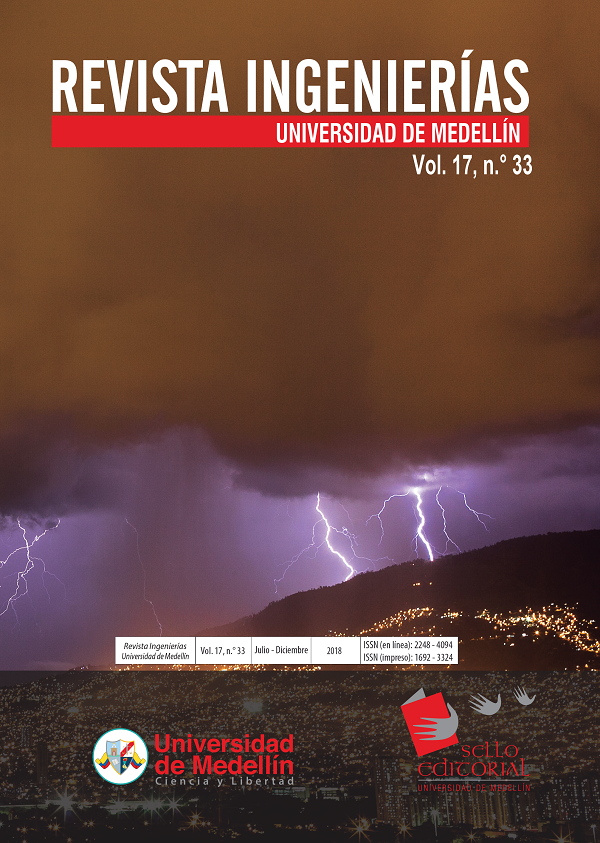Floor Accelerations for the Design of Non-Structural and Structural Elements that are not Part of the Seismic Resistance System in Buildings
Main Article Content
Abstract
The purpose is to evaluate the method used in the Colombian Earthquake Resistant Construction Regulations (NSR-10) to calculate the floor accelerations that are necessary to design non-structural elements and structural elements that are not part of the seismic resistance system. The study compares the maximum floor accelerations calculated with NSR-10, ASCE 7-10, UBC-97, Eurocode 8-04 and NZS 1170.5-04, with the maximum floor accelerations measured in specimens tested on a vibrating table, and in existing buildings during real earthquakes. The article also proposes a modification to the method currently used by NSR-10. The proposed modification generates a more accurate estimate of the accelerations needed to design these elements in medium and high-rise buildings. The proposed recommendations are based on the results of the evaluation of the method currently used in NSR-10, the procedure used in other seismic-resistant standards, experimental results measured in reinforced concrete structure models and accelerations recorded in instrumented buildings.
Article Details
References
[1] M. Rodríguez, J. Restrepo y J. Carr, 'Earthquake-induced floor horizontal accelerations in buildings,' Journal of Earthquake Engineering and Structural Dynamics, vol. 31, pp. 693-718, 2002.
[2] J. Jaramillo, 'Evaluación aproximada de la aceleración absoluta en sistema de múltiples grados de libertad considerando la participación de n formas modales,' Revista Internacional de Desastres Naturales, Accidentes e Infraestructura Civil, vol. 4, N°. 2, pp. 87-98, 2005.
[3] J. Carrillo y G. González, 'Evaluación de la demanda sísmica fuera del plano en edificios,' Revista Ciencia e Ingeniería Neogranadina, vol. 15, pp. 44-61, 2005.
[4] NSR-10, Reglamento Colombiano de Construcción Sismo Resistente ‒NSR-10, Asociación Colombiana de Ingeniería Sísmica, AIS, Tomo 1, Bogotá, 2010.
[5] ASCE 7-10, Minimum design loads for buildings and other structures, ASCE/SEI 7-10, Reston, VA, 2010.
[6] UBC-97, 'Uniform building code - Vol. 2: Structural engineering design provisions,' presentado en International Conference of Building Officials, Whittier, California, EE. UU., 1997.
[7] Eurocódigo 8-04, Design of structures for earthquake resistance, European Committee for Standardization, 2004.
[8] NZS 1170.5-04, New Zealand Standard: Structural design actions - Part 5: Earthquake actions. Standards, Nueva Zelanda, 2004.
[9] FEMA, Reducing de risks of nonstructural earthquake damage -A practical guide, FEME E-74, Washington, 2012.
[10] FEMA, NEHRP recommended provisions for seismic regulations for new buildings and other structures, Part 1: Provisions, FEMA 302, Washington, 1997.
[11] FEMA, NEHRP recommended provisions for seismic regulations for new buildings and other structures, Part 2: Commentary, FEMA 303, Washington, 1997.
[12] EngSolutions RCB, Structural software for analysis and design of reinforced concrete buildings for earthquake and wind forces, V8.5, EngSolutions, Inc., Florida, 2015.
[13] M. Sozen, S. Otani, P. Gulkan y N. Nielsen, 'The University of Illinois earthquake simulator,' presentado en Proceedings of the 4th World Conference on Earthquake Engineering, Santiago de Chile, vol. III, 1969.
[14] A. Lepage, J. Shoemaker y A. Memari, 'Accelerations of nonstructural components during nonlinear seismic response of multistory structures,' Journal of Architectural Engineering, ASCE, vol. 18, N°. 4, pp. 285-297, 2012.
[15] J. Aristizabal y M. Sozen, 'Behavior of ten-story reinforced concrete walls subjected to earthquake motions', Structural Research Series, N°. 431, Univ. of Illinois, Urbana, Illinois, 1976.
[16] J. Lybas y M. Sozen, 'Effect of beam strength and stiffness on dynamic behavior of reinforced concrete coupled walls,' Structural Research Series, N°. 444, Univ. of Illinois, Urbana, Illinois, 1977.
[17] D. Abrams y M. Sozen, 'Experimental study of frame-wall interaction in reinforced concrete structures subjected to strong earthquake motions,' Structural Research Series, n°. 460, Univ. of Illinois, Urbana, Illinois, 1979.
[18] J. Moehle y M. Sozen, 'Experiments to study earthquake response of R/C structures with stiffness interruptions,' Structural Research Series, n°. 482, Univ. of Illinois, Urbana, Illinois, 1980.
[19] T. Healey y M. Sozen, 'Experimental study of the dynamic response of a ten-story reinforced concrete frame with a tall first story,' Structural Research Series, n°. 450, Univ. of Illinois, Urbana, Illinois, 1978.
[20] J. Moehle y M. Sozen, 'Earthquake simulations tests of a ten-story reinforced concrete frame with discontinued first-level beam,' Structural Research Series, n°. 451, Univ. of Illinois, Urbana, Illinois, 1978.
[21] H. Ceceen, 'Response of ten-story reinforced concrete model frames to simulated earthquakes,' Ph.D. thesis, Univ. of Illinois, Urbana, Illinois, 1979.
[22] A. Schultz, 'An experimental and analytical study of the earthquake response of R/C frames with yielding columns,' Ph.D. thesis, Univ. of Illinois, Urbana, Illinois, 1985.
[23] S. Wood, 'Experiments to study the earthquake response of concrete frames with setbacks,' Ph.D. thesis, Univ. of Illinois, Urbana, Illinois, 1986.
[24] M. Eberhard y M. Sozen, 'Experiments and analyses to study the seismic response of reinforced concrete frame-wall structures with yielding columns,' Structural Research Series No. 548, Univ. of Illinois, Urbana, Illinois, 1989.
[25] NEEShub, 'The George E. Brown, Jr. Network for Earthquake Engineering Simulation,' [En línea], Disponible: https://nees.org/warehouse, 2017.
[26] CESMD, 'Center for engineering strong motion data,'USGS, CGS, ANSS. [En línea], Disponible: https://www.strongmotioncenter.org, 2017.
[27] R. Drake y R. Bachman, '1994 NEHRP Provisions for Architectural, Mechanical, and Electrical Components,' presentado en Proceedings of the 5th U.S. National Conference on Earthquake Engineering, 1994.
[28] R. Drake y R. Bachman, 'Interpretations of instrumented building seismic data and implications for building codes,' presentado en Proceedings of the 1995 SEAOC Annual Convention, 1995.
[29] R. Goel y A. Chopra, 'Period Formulas for Moment-Resisting Frame Buildings,' Journal Structural Engineering, ASCE, vol. 123, N°. 11, pp. 1454-1461, 1997.





